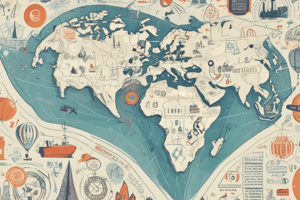Podcast
Questions and Answers
Which of the following best describes globalization?
Which of the following best describes globalization?
- The isolation of countries to preserve unique cultures and traditions.
- The reduction in the Earth's physical size due to technological advancements.
- The focus on local production and consumption to reduce international dependencies.
- The increasing interconnectedness of the world through communication, trade, and the sharing of ideas. (correct)
How have developments in technology impacted globalization?
How have developments in technology impacted globalization?
- They have slowed down the process of globalization by creating digital divides.
- They have led to increased protectionism and trade barriers.
- They have had no significant impact on globalization.
- They have accelerated globalization by making communication and transportation faster and more efficient. (correct)
What role did colonization and exploration play in the early stages of globalization?
What role did colonization and exploration play in the early stages of globalization?
- They facilitated the exchange of ideas, cultures, and technologies between different countries. (correct)
- They had no impact on the development of globalization.
- They primarily focused on military conquest and resource extraction, with little cultural exchange.
- They hindered globalization by creating isolated empires.
Which transportation advancement most significantly contributed to globalization by making the transport of bulky goods quicker and easier?
Which transportation advancement most significantly contributed to globalization by making the transport of bulky goods quicker and easier?
How has the introduction of the petrol engine impacted transportation and globalization?
How has the introduction of the petrol engine impacted transportation and globalization?
Which of the following illustrates how communication technology has propelled globalization?
Which of the following illustrates how communication technology has propelled globalization?
According to the material, government reforms in India during the 1990s influenced globalization by:
According to the material, government reforms in India during the 1990s influenced globalization by:
What is the role of the European Union in promoting globalization?
What is the role of the European Union in promoting globalization?
How can globalization lead to a more homogenous society?
How can globalization lead to a more homogenous society?
Which of the following best describes a heterogeneous society in the context of globalization?
Which of the following best describes a heterogeneous society in the context of globalization?
What is the relationship between Transnational Companies (TNCs) and globalization?
What is the relationship between Transnational Companies (TNCs) and globalization?
How can globalization positively impact lower-income countries?
How can globalization positively impact lower-income countries?
What is a potential negative impact of globalization on small businesses?
What is a potential negative impact of globalization on small businesses?
How does globalization contribute to the spread of diseases?
How does globalization contribute to the spread of diseases?
How did developments in aviation affect globalization?
How did developments in aviation affect globalization?
What advantages do automated technologies, like drones, offer to businesses in the context of global transport?
What advantages do automated technologies, like drones, offer to businesses in the context of global transport?
How did satellite communications influence globalization?
How did satellite communications influence globalization?
What problem did the introduction of larger container ships cause to the London Docklands in the 1960s?
What problem did the introduction of larger container ships cause to the London Docklands in the 1960s?
How might globalization pose a 'threat to diversity'?
How might globalization pose a 'threat to diversity'?
When did it become more popular for goods to be transported by air?
When did it become more popular for goods to be transported by air?
Flashcards
What is globalisation?
What is globalisation?
The increasing interconnection of the world through communication, trade, investment, and the sharing of ideas.
Factors affecting globalisation
Factors affecting globalisation
Advancements in technology, especially in communication and transport, have significantly accelerated globalisation.
Internal combustion engine
Internal combustion engine
Engines that burn fuel internally to generate power, used in cars, planes, and other vehicles.
Container ships (1950s)
Container ships (1950s)
Signup and view all the flashcards
The Internet
The Internet
Signup and view all the flashcards
Satellite communications
Satellite communications
Signup and view all the flashcards
Mobile phones
Mobile phones
Signup and view all the flashcards
Social networking
Social networking
Signup and view all the flashcards
Transnational companies (TNCs)
Transnational companies (TNCs)
Signup and view all the flashcards
Heterogeneous society
Heterogeneous society
Signup and view all the flashcards
Homogeneous society
Homogeneous society
Signup and view all the flashcards
Positive impacts of TNCs
Positive impacts of TNCs
Signup and view all the flashcards
Negative impacts of TNCs
Negative impacts of TNCs
Signup and view all the flashcards
Threat to diverstiy
Threat to diverstiy
Signup and view all the flashcards
Pollution increases
Pollution increases
Signup and view all the flashcards
Disease spread
Disease spread
Signup and view all the flashcards
Study Notes
- Globalisation refers to the increasing interconnectedness of the world.
- Globalisation involves communication between people, world trade, international investment, and the sharing of ideas.
- Globalisation has led to the internationalisation of people, companies, and governments.
- Communication and travel are much faster than in the past, like in the 1800s when it took days or weeks for a letter to arrive.
- Now, it only takes seconds to communicate with someone on the other side of the world via phone, text, or email.
- Globalisation's origins can be traced to the Middle Ages with colonisation and exploration facilitating the sharing of ideas, cultures, and technologies.
- Advancements in communication and transport technologies have accelerated the pace of globalisation.
- It's difficult to imagine a country not influenced by the wider world, from food to music to clothing.
Factors Affecting Globalisation
- Advancements in technology have significantly contributed to globalisation.
- New technologies have enabled companies to become more global and connect across the world more easily.
- Travel has evolved remarkably since the 19th century.
- The internal combustion engine, railways, and aeroplanes enable travel from one country to another much faster than in the 17th century.
- People previously relied on horses or ships.
- The petrol engine led to the usage of cars, buses, lorries, and the construction of extensive highway networks.
- Aviation developments allow for the quick transport of passengers and freight over long distances.
- Newer technologies have enabled automated transport, and the use of drones and easy ship loading/unloading reduces business costs.
- Container ships introduced in the 1950s enable quick and easy transportation of bulky goods.
- Containers facilitate handling goods anywhere with specialized ships, lorries, and cranes.
- Suppliers can move goods quicker and more efficiently from lorries onto ships.
- Shipping goods has become cheaper for many suppliers, making the global market more accessible.
- The large container ship sizes caused problems for the London Docklands in the 1960s, leading trade to move to deepwater docks like Dover and Felixstowe.
- The 21st century has seen significant advancements in communication technology, driving globalisation and breaking down political and cultural barriers.
- The internet enables instant communication for people and businesses.
- Satellite communications provide a global view and communication links, facilitate TV and telephone communications.
- Mobile phones enable communication and internet access.
- Social networking connects people worldwide.
- Transnational companies (TNCs) can develop in countries worldwide and be monitored from a headquarters in a developed country.
- Reduced communication time enables companies to work more efficiently and reduce costs.
- Government decisions can significantly impact globalisation.
- Government reforms in India during the 1990s brought more foreign investment and a rise in TNCs.
- India is now one of the leading countries on the world market behind China.
- Partnerships with other countries make trade easier and reduce costs; the European Union aims to ensure the free movement of people, goods, and services within its member countries.
Impacts of Globalisation
- Globalisation has shaped cultures and identities into both homogenous and heterogenous societies.
- A heterogeneous society has a wide variety of races, religions, cultures, beliefs, and leisure activities.
- A homogeneous society has less variation in cultures, beliefs, and languages spoken.
- Globalisation can even affect films and food, with the emergence of the same shops and trends in areas across the world.
Positive Impacts
- Transnational companies developing in lower-income countries can improve the economy and provide new jobs and skills.
- It's easier to connect and stay updated with foreign news and events.
- People can experience new countries and cultures through the media and better transport.
- It is possible to buy cheaper products from abroad.
- Countries can share ideas and develop new technologies together.
Negative Impacts
- Transnational companies can exploit poorer countries for their resources, with low pay or illegal working conditions.
- Small businesses are forced to close because of the competition from global chain stores.
- Diversity diminishes with towns and cities becoming more uniform.
- Large amounts of pollution are created by air travel and the movement of goods on ships and lorries.
- Diseases like Covid-19 can spread from one country to another more easily.
Studying That Suits You
Use AI to generate personalized quizzes and flashcards to suit your learning preferences.




